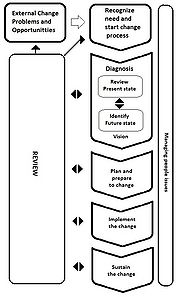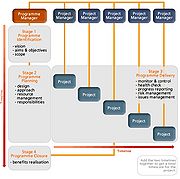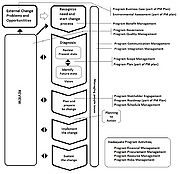The Role of Program Management in an Organisational Change
Organisations generally understand that they need to embrace change in order to remain competitive and achieve strategic goals. However, many struggle to manage all aspects of the change process missing key components as smooth implementation and solid support throughout[1]. To become a master in managing your change management program is a key factor to the success of your organisational change. The simple fact is change have both negative and positive effects in any organisation. Managed poorly, the process creates major problems for the culture and people. Managed well, it provides the platform for growth and success.
Abstract:Organisational change is a huge alteration for any company and can be a dawning task if not managed properly. An organisational change usually consist of a wide range of related change projects and other activities, which align with the overall strategic goal for the future of the company. Program management is a great method to cope with an organisational change, as it consist of a toolbox that evaluate each potential change project. Program management will support managers by providing overview, efficient execution of projects, project alignment, evaluated risks, stakeholder map and create the highest amount of benefits. All which point toward a more effective and efficient change management process. This article focus on how an organisation can manage their change projects through a change management program. Research papers and books regarding change management will form the bases of the change management approach. In addition, program management methods and tools will structure the approach, guarding the overall change process. The result are to be found in the Application of Program Management where the overall subject is discussed. This article is a application-oriented overview and summary.
Contents |
Change Management
There is not a single recipe for Change Management that can be applied to all organisations at all times. The subject is simply too complex. The most simplified way of viewing the change process is through Lewin´s three-step change process [J. Hayes, 2010];
All types of change initiatives have to start the change process by unfreezing from their current status quo. When talking about change unfreezing is the first and the most essential change of the whole change process. Unfreezing creates the conditions that facilitate transitioning, moving the organisation to a new state. Viewing at organisational change compared to other change initiatives, organisational change is the most intensive; hence, it got the capability of re-orientate or re-crate parts of or the entire organisation [J. Hayes, 2010].
Change is often managed less effectively than it might be because those responsible for managing it fails to attend to some of the critical factors and aspects of the change process. This issue have already had its impact on organisations whose employees had bad experience with change initiatives, and are more reluctant to change than others. To enable managers to cope with change, the Key Steps In the Change Process are presented [J. Hayes, 2010].
At first glance, it seems like change is a rational and linear process. Nevertheless, this is rarely how it unfolds in practice. The model is a systematic process that guide managers through all the relevant stages that a change initiative have to take into account from planning to implementation. One of the key aspects in the change process is Reviewing and Managing people issues throughout the entire process. Which are the most important factors for the managers to contemplate and manage when initiating in an organisational change, due to the fact that employees are the one whom are able to make the organisational change possible.
Survival of the fittest We all know Darwin´s evolutionary theory[2], including the theory of natural selection. In 1864, Herbert Spence interpreted Darwin´s theory into the financial world, and came up the more popular phrase Survival of the fittest[3]. This might seem fare fetched from organisational change. Nevertheless, organisations have a huge range of operations and systems, which interconnect, but also operate independently - much like the animal kingdom.
The point here is that when an organisation develops a re-orientation or a re-creation of the company, it is time to kill your darlings and manage the change to ensure survival of the fittest operations and systems. A less impactful change can be adopted on strong operations to ensure their survival in the future. Thus making the company future-proof. Another important aspect - previously stated - is managing people issues. If a manager cut an operation of the agenda, the employees feels dumped. Why it is important for the whole organisation to understand that, the overall system gets stronger when some components destroyed or replaced by others Nassim Nicholas Taleb. Here, managers should strive for social coherence and acceptance throughout the entire organisation, to ensure that all parts of the organisation is as ready as possible for the change ahead.
Their are many challenges regarding organisational change. Managers in charge of the operation, must research, analyse and handle challenges carefully in order to succeed. Factors which cause failure [4]. Barriers in Change Management [5], [6]. Best Practice challenges in Change Management [7], Human Resource Best Practice in organisational change [8].
Further investigation on the change process will not be conducted in this article. Relevant literature for managing change are presented here;
2010, The Theory and Practice of Change Management, John Hayes. - 2011, Facilitation Change, Lauge Baungaard Rasmussen. - 1996, Leading Change, John P. Kotter.
When talking about selection of operations and change initiative. A change manager will benefit from evaluating the effect, risk, the amount of resources and a general overview of the different change initiatives ahead. All these aspects can be drawn towards Program Management, which will be explained in the next section.
Program Management
A program is a set of projects identified by a given organisation that will deliver a defined objective. Roughly speaking, a project provide deliverables, program provide benefits and portfolio provide strategic guidance [J. Oehmen, Lecture 6]. A program can only succeed if the projects within the program are completed, and without it the projects will be uncoordinated and not integrated in the final goal. Program management is a structured way of managing change initiative and be proactive towards change, moreover it provides a solid framework for handling complexity and risks [9].
Program Management provide following benefits;
- Definition of projects to generate deliverables that together will provide the desired benefit - Active coordination of project execution - Effecient execution (common governance and processes)
Further difinition; Goal; Deliver benefit: High level objective comprised of multiple deliverables. Role of Change; Change management “creates value”: It is pro-active and adaptive to focus program on an evolving understanding of benefits, capabilities and environment. Relatedness of components; While sub-projects create physically distinct deliverables, there is a strong mutual dependence. Planning; Life-cycle perspective to develop definition of deliverable. Time Scale; Duration of system lifecycle: Years to 10s of years. Effecientcy; Coordination among projects. Effectiveness; Understand and operationalize “benefits”.
The basis of Program Management have now been presented, the following section will briefly describe the methods and tools integrated in the perception of Program Management.
Tools and Methods
Program Managements Performance Domain
PMI: Standard for Program Management, 2013, state following domains which Program Management interact with[10]. Each domain holds different tools and methods which all are useful for managers to cope with organizational change and program management in general. The four elements features; Program Strategy Alignment, Program Benefit Management, Program Stakeholder Engagement, Program Governance and Program Life Cycle Management, each will be explained in the sections below.
Program Strategy Alignment
Strategy alignment will support managers in identifying opportunities and benefits to achieve the organization's strategic objectives through program implementation. For managers to ensure a strategic alignment, the Elements of Program Strategy Alignment is a structured way to get there, it consist of the four elements illustrated in the figure.
Program Business Case, asses balance between costs and benefits of the program. A detailed description of the value the program are to deliver and justification of the resources used in the program. Other relevant elements; Details about problems or opportunities, business and operation impact, cost benefit analysis, alternative solutions, financial analysis, potential profit, social need/coherence, risks and the programs alignment towards the organisations strategic objects.
Program Plan, is the clarification of the organisation´s concept, vision, mission and benefits created by the proposed program. Further more it defines goals and objectives.
Program Roadmap, describe dependencies between major milestones, illustrate the link between planned work and business strategy, reveal gaps – lost time, highlights milestones, summarize objects, challenges and risks, indicate required infrastructure.
Environmental Assessments, help managers to understand the surrounding environment, understand opportunities and threats that are to be exploited and/or mitigated by the program. Other relevant elements would be; SWOT analysis, relevant historical information, analysis and documentation of key assumptions.
Program Benefit Management
Defining, creating, maximizing, delivering, and sustaining the benefits provided by the program. Other relevant elements; Benefit Identification, Benefit Analysis and Planning, Benefit Delivery, Benefit Transition and Benefit Sustainment.
Program Stakeholder Engagement
Capturing and understanding stakeholder needs, desires, and expectations and analysing the impact of the program on stakeholders, gaining and maintaining stakeholder support, managing stakeholder communications, and mitigating/ channelling stakeholder resistance. Identifying and prioritising stakeholders, usually done in a Stakeholder Map. Stakeholder engagement plan is a potent solution to how an organisation should interact with each stakeholder group, regarding communication, consultation and their role in execution. Moreover, an activity plan should be created to manage stakeholders.
Program Governance
Establishing processes and procedures for maintaining program management oversight and decision-making support for applicable policies and practices throughout the course of the program. Program Governance is needed cause it provide the basis of, decision making, alignment of objectives, funding, communication, control and supporting activities. Supporting activities could consist of; Program Management Office, Program Management Information System, Knowledge Management, Auditing Support and Education and Training.
Program Life Cycle Management
Managing all of the program activities related to program definition, program benefits delivery, and program closure. Program Life Cycle Management is the cornerstone and interact with all the subjects mentioned above.
There are three phases within Program Life Cycle Management, which will be briefly described; More information can be found !APPPM!SOMEONESTOPIC
Program Definition, is needed to elaborate on business case, conduct feasibility studies and trade-off analysis, iterative development of business case, program plan and program roadmap and hereby create the basis for approval of the program. Program Benefit Delivery Phase, execute the bulk of the program work aimed to deliver the desired benefits. Program Closure Phase, ensure a controlled ending of the program. Here it would be beneficial to document best practice and lesson learned.
To end this chapter about Program Management a list of relevant support activity is listed. Program Communication Management, Program Financial Management, Program Integration Management, Program Procurement Management, Program Quality Management, Program Resource Management, Program Risk Management, Program Schedule Management and Program Scope Management.
The need of support is huge when engaging in an organisational change, and managers must pick and chose in relation to what components will have the highest amount of value. The following chapter will apply the structure of Program Management to an organisational change.
Application of Program Management
A set of related projects not managed as a program are likely to run off course and fail to achieve the desire outcome [11]. It is important that programs run within a framework that ensures there is a focus on the overall strategic objectives. Applying the Program Management within a framework is crucial to control and implement. Program Managers have developed a wide range of frameworks I have chosen one called, Program Management Stage Mapping. The model illustrate how an organisation can visualise their Change Program and furthermore it illustrates four stage, which will briefly be introduced [12].
Stage 1: Program Identification, is where the strategy and direction of the company is decided. A program plan is produced, to outline the business case, alignment to strategy, scope and the expected objectives and benefits. Stage 2: Program Planning, is where the design of the program is takes place. Program Manager should establish following; Define clear objectives, Agree on approach, Agree on roles and responsibility, Set-up communication channels, Agree on priorities of projects within the program. Stage 3: Program Delivery, is an ongoing process alongside the projects. Program Managers monitor the progress, assess risks and report to committee. Moreover, it is important that the Program Manager ensure that projects are aligned with objective and strategy. Stage 4: Program Closure, is done when objectives and benefits are reached. As a final task Program Managers must review the entire process, and document lesson learned. Every stage can conduct more or less models and methods, which are up to the managers and the organisation as a whole to decide.
Aplication of Program Management in an Organisational Change
“Program Management is a structured framework for defining and implementing change within an organization” - James J Leal[13]
As J. Leal point out, the structured framework of Program Management is a helping hand to implement several change initiative in an organisation. To further investigate where Program Management benefit and have impact on an organisational change - the methods and tools from Program Management is presented alongside Steps In the Change Process.
One important aspect form Program Management that been left out is, Life Cycle Management. Hence, it controls the overall project, ensuring benefits and a controlled ending of the change program. Which is important to sustain the overall change in an organisation.
Contribution of Program Management
Inadequate Program Activities, seen in the figure, is what the change process lack. It is clearly seen that the steps in a change process neglect most of the financial part. Which is very important aspect if an organisation plan to re-orientate or re-create their organisation. Moreover, the wide range of analysis, planning and activity tools within Program Management are will definitely support the overall change process, by structuring and plan in great detail. This is important, course when an organisation engage in an organisational change you have to make sure that the company survive the change and hopefully benefit from it.
Contribution of Change Management
Change Management recognise that people within the organisation is one of the most important aspect of a success full change. Why people issues is relevant throughout the entire Change Program. While most of the structure is done within Program Management – Change Management on the other hand, have a great deal of knowledge about implementation, and will support the Program Managers by addressing the right issues when engaging in an Organisational Change.
It is clear that the expertise of a Change Manager, support a Program Manager and counter wise - why the expertise together form a reliable execution of an Organisation Change Program.
Conclusion
If any is needed?





